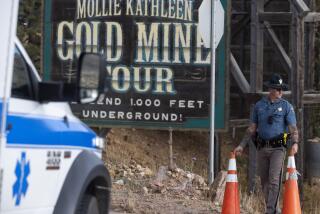Utah mine will close for good
- Share via
Executives at the Murray Energy Corp. said Wednesday that the Crandall Canyon Mine, where six men were trapped and apparently killed by a cave-in Aug. 6, will be closed permanently.
The decision probably means the miners will be entombed 1,500 feet below the surface in the collapsed coal mine, although efforts to look for signs of life were continuing.
Attempts to reach the trapped men over the last two weeks have failed, and holes bored into the mine have found little breathable air. On Wednesday, a fifth bore hole found only a 6-inch-deep void, and a microphone lowered into the space picked up no sound. Officials said they planned to begin drilling a sixth hole today in the area where the miners were believed to have been working.
Three rescue workers trying to reach the miners were killed in another collapse last week.
Rob Moore, vice president of Murray Energy, said the company was notifying federal officials and the miners’ families of its decision to abandon the Huntington, Utah, operation.
The company earlier had indicated that it might reopen parts of the mine that were not affected by the collapse. That suggestion drew harsh criticism from the miners’ families; newspaper editorials called for a permanent closure.
Murray Energy Chief Executive Robert E. Murray now says the site is too hazardous to operate.
“I will never go back in there,” Murray said in an interview to be broadcast today on National Public Radio. “Things happened here that have never happened. I have men here that have hundreds and hundreds of years of mining experience. They never saw this before, never before. The mountain is alive. It’s a deadly mountain, and I’m not going near it.”
Murray has said the disaster was triggered by an earthquake. Seismologists registered a magnitude-3.9 event when the mine collapsed but believe it was caused by the cave-in.
Jerry C. Tien, a professor of mining engineering at the University of Missouri-Rolla, said he was not surprised by Murray’s decision to close the mine -- both because of the apparent safety problems at the site and the questionable economics of the operation.
“The mining conditions are obviously not the best,” Tien said.
What caused the collapse remains unclear. The Crandall Canyon mine relied on a system of massive coal pillars to support its roof, a typical arrangement in deep coal mines. The collapse of a pillar can be triggered by geologic factors or engineering errors in calculating the loads on pillars.
Tien said that the mine had only about 30 months of coal reserves remaining and that a lengthy shutdown would add significantly to the maintenance costs of restarting the operation.
The decision to shut down the mine and leave the bodies underground is not unprecedented.
“We do everything we can to recover bodies, but sometimes it is not physically possible,” Tien said. “It is a question of how much money and how much additional risk we are going to take to recover the bodies.”
--
More to Read
Sign up for Essential California
The most important California stories and recommendations in your inbox every morning.
You may occasionally receive promotional content from the Los Angeles Times.














